The land of Quang is very beautiful with the rustic sincerity of the people to a gentle and pleasant pace of life. Having the opportunity to come to Hoi An, you can visit famous temples to explore interesting cultural and artistic corners. The temples here also have a very Hoi An color with the main yellow color. Not only the unique architecture is delicate to every detail, the peace here also helps visitors feel some of the purity from the space spreading to their minds. Let's find out with Topshare the most famous and unique sacred temples in Hoi An with some reference information below!
1 Hoi An Bridge Pagoda
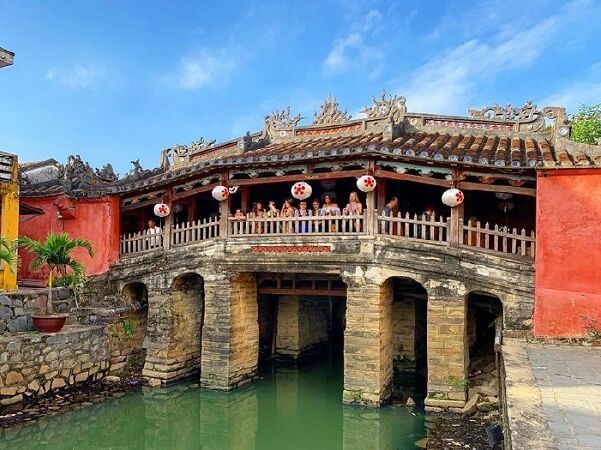
Hoi An Bridge Pagoda - Photo: Pinterest
Address: Nguyen Thi Minh Khai Street, Hoi An Ancient Urban Area, Quang Nam Province.
The first pagoda that Tico Travel would like to introduce to you is Hoi An Bridge Pagoda, this pagoda is considered a cultural, historical and architectural symbol of Hoi Street. The Bridge Pagoda was built by the Japanese around the 17th century, so it is also known as the Japanese Bridge, to serve many different purposes.
First, the bridge was built to trade between the two banks of the river, one side is the area where the Chinese live, the other is the Japanese. Second, at this time appeared a monster named Namazu, with a head in India, a body in Vietnam and a tail in Japan, Every time there is an earthquake, this monster immediately turns around, causing countless disasters for the people in Hoi An. To suppress the water monster, this pagoda was built to block its back, from which the three countries returned to a peaceful and increasingly flourishing life.
In fact, the original architecture of Hoi An Bridge Pagoda only consisted of a bridge across a small tributary of Thu Bon River. Until later, when the Japanese left, the Minh Huong people – A Chinese community still living in Hoi An together built more pagodas, worship Northern Emperor Zhenyu, with the hope that the god can protect people from natural disasters, bringing a peaceful life to this place.
Therefore, it can be said that Hoi An Bridge Pagoda is not only a place of trade in history, but also a cultural intersection of the three countries Vietnam – Japan – China in history, with architectural evidence preserved to this day.
2 Hoi An Fujian Temple
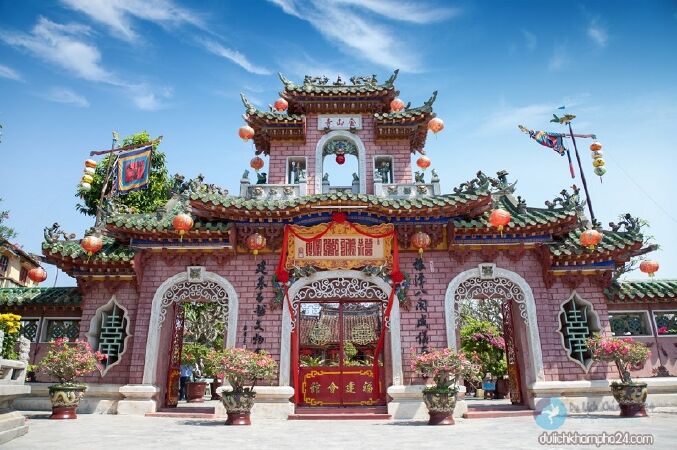
Hoi An Fujian Temple - Photo: dulichkhampha24
- Address: 46 Tran Phu – Cam Chau – Hoi An
Opening hours: from 07:00 to 17:00 daily
Ticket price: 80,000 VND/Vietnamese and 120,000 VND/foreigner
This Hoi An temple was built around the 17th century by Hoi'an Hokkien people (Fujian is the homeland of the Qiao Chinese people). It is a place of spiritual and cultural activities associated through many periods of people in Hoi An. Hoi An Fujian Temple was formerly just a small temple dedicated to Thien Hau Holy Mother – God bless merchants smooth sailing on ocean trips and also a meeting place for Hokkien people – the earliest human community in Hoi An at that time.
3 Ông Hoi An Pagoda
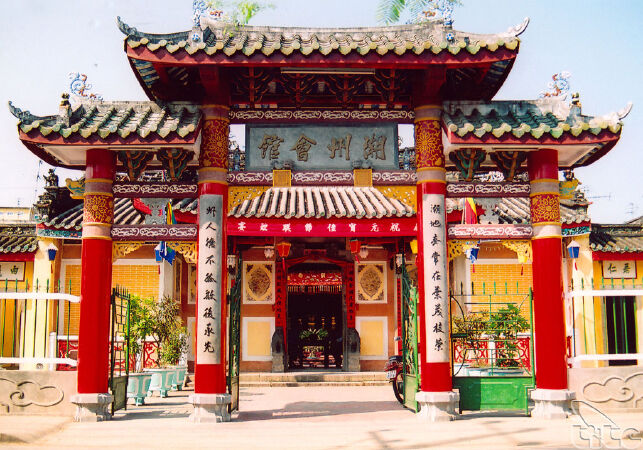
Ông Hoi An Pagoda - Photo: Pinterest
Address: 24 Tran Phu – Cam Chau – Hoi An
Ông Hoi An Pagoda, also known as Quan Cong Temple, was built by the Chinese community in Hoi An around the middle of the 17th century. For the purpose of worship, praising the merits of Quan Quan Truong or Quan Cong – A talented general of the Three Kingdoms period who represents the philosophy of life "Nghia – Tin – Trung – Dung". Ông Hoi An Pagoda was granted the status of National Historical-Cultural Monument on November 29, 1991.
This pagoda in Hoi An has a majestic appearance with the "Quoc" type, showing the unique Chinese architectural beauty in every line such as the tiles of colored enamel tiles, 4 pavilions built in the "Kou" type, plus the statue of Quan Cong placed in the main hall solemnly, His eyes showed a firm expression, making Ông Hoi An Pagoda more sacred than ever.
4 Phap Bao Pagoda
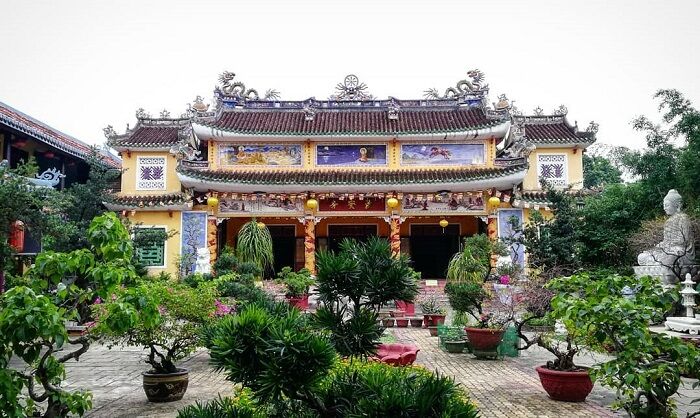
Phap Bao Pagoda - Photo: Pinterest
Address: No. 07 Hai Ba Trung – Tam Quan – Hoi An
Phap Bao Pagoda is only about 750m from the center of Hoi An ancient town, this location makes it convenient for you to move while visiting Hoi An ancient town. The construction time of this pagoda is currently unknown, the latest restoration was carried out in 2000 and was granted the status of national historical-cultural relic on February 17, 2020 1990.
This Hoi An pagoda has a monumental scale, built in two-storey architecture, bearing the beauty of the ancient house of Hoi Street. Like other pagodas in Vietnam, inside the Phap Bao Pagoda there are many statues of Buddha, Kannon Buddha, Guardians ,... has a majestic and tranquil appearance.
5 Vien Giac Pagoda
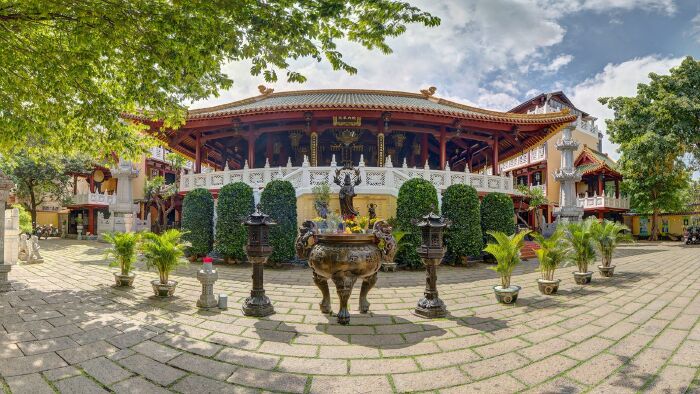
Vien Giac Pagoda - Photo: Phatgiao.org.vn
Address: 34 Hung Vuong – Cam Pho – Hoi An
The predecessor of Vien Giac Pagoda was the village pagoda named Cam Ly in Xuyen Trung. But because of its old location next to the river, the land along the bank was eroded, so in 1841, this pagoda was moved by King Thieu Tri to 34 Hung Vuong – Hoi An today.
Vien Giac Pagoda is a few ancient Hoi An temples, but mixes modern architecture of Asian shades, with traditional Vietnamese and Chinese architecture. This temple was granted the status of National Historical-Cultural Monument on 29/11/1991.
The temple has a simple layout, but still exudes majesty. In the middle of the altar is a statue of the meditating Shakyamuni Buddha seated on the lotus calyx, in front of which are statues of infant Shakyamuni, Guan Shiyin and Tibetan Bodhisattva decorated on either side.
6 Ba Mu Hoi An Pagoda
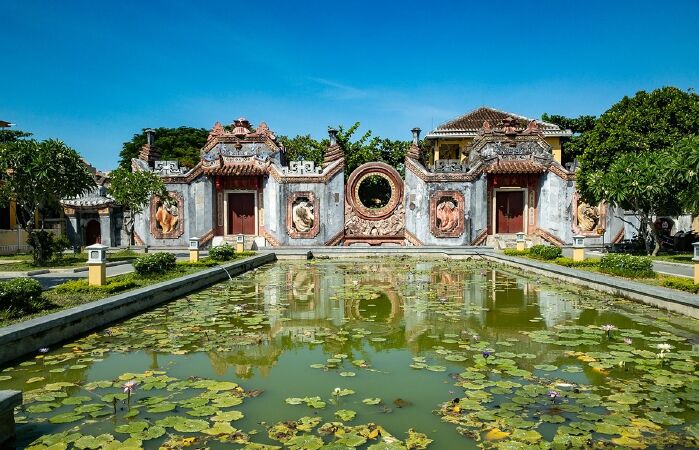
Ba Mu Hoi An Pagoda - Photo: Pinterest
Address: No. 675 Hai Ba Trung Street – Tam Quan – Hoi An
This is probably the most visited and photographed Hoi An temple among the pagodas in the old town. Partly because the location is easy to find, partly because the ancient, fancy architecture makes the photo frame of visitors more shimmering than ever. Ba Mu Hoi An Pagoda was built in 1926 by the Minh Huong people in Hoi An, but the current appearance of this pagoda is mostly the result of a restoration in 2018.
Impressing visitors at first sight is the three-view gate with a distinct design, bold Asian style, the wall array has many eye-catching motifs, and has been tinged with time. The photogenic point of the pagoda is probably the scene of gun lake in the foreground, making the scene of Hoi An Pagoda poetic in the eyes of those who miss this pagoda.
7 Van Duc Pagoda
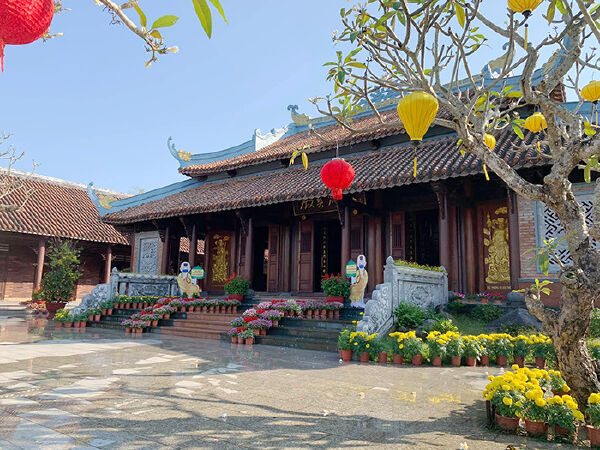
Van Duc Hoi An Pagoda - Photo: Pinterest
Address: Hamlet 2B, Cam Ha Ward – Hoi An
Van Duc Pagoda was built and at the end of the 17th century, Ancestor Kaishan was Zen Master Mingliang – a Zen master from Cantonese, China. This Zen master resided in Hoi An and was donated land by a Buddhist to set up a small temple for his practice, then expanded the scale into a pagoda. At first, the temple was named Lang Tho temple, Cay Cau pagoda and Van Duc pagoda were later names. Van Duc Pagoda was classified as a national monument in 1991.
This Hoi An temple belongs to the Northern sect of the Northern sect, this temple is mentioned as a scenic spot of Hoi An during the Great Southern Unification Solstice. Thanks to the artistic layout, unique architecture, in addition, this place also preserves many precious artifacts of Zen master Minh Luong, the painting of King Minh Mang with wooden planks, the monk of Pho Triem's nest,,... making Van Duc Pagoda have an incredible attraction.
8 Hai Tang Hoi An Pagoda
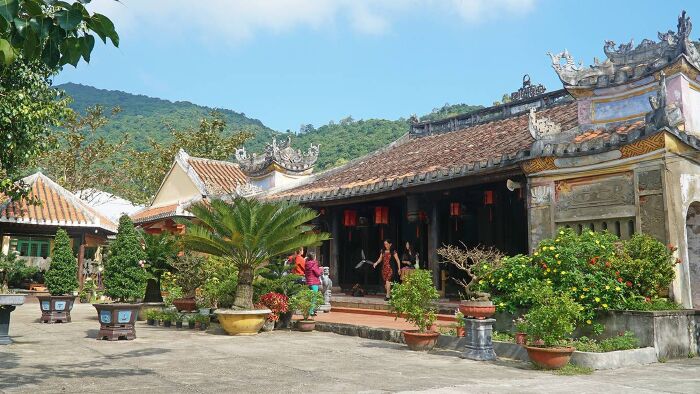
Hai Tang Hoi An Pagoda - Photo: Pinterest
Address: Cham Island, Hoi An, Quang Nam province
Hai Tang Hoi An Pagoda was built in 1758, but in 1848 this Hoi An temple was severely damaged by a typhoon, forcing it to move to another location, about 200m away. The name of Hai Tang Hoi An Pagoda, in which "Hai is the sea", "Tang is the Tripitaka sutra", refers to the teachings of the Buddha as rich and immense as the sea.
It is said that around the seventeenth century a group of people passed through Cham Island, but because of the high waves and winds, they could not move, forced to stay on the island. In the days that followed, the weather did not change, so one of the group came to ask at the temple next door. The local god here pointed out that, in order to calm the waves, he must take a wooden tree to build a pagoda here, as instructed, after the pagoda is erected, the group can continue to sail safely, this Hoi An pagoda was formed from there.
9 Phuoc Lam Hoi An Pagoda
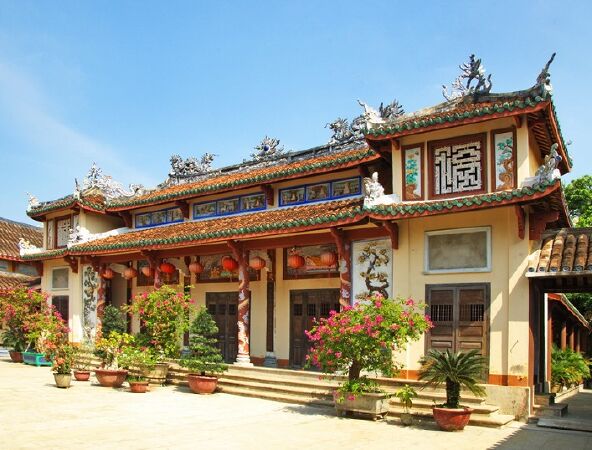
Phuoc Lam Hoi An Pagoda - Photo: Pinterest
Address: Cua Suoi village, Cam Ha commune, Hoi An
Phuoc Lam Pagoda was built around the 17th century, by the monk Minh Son. This Hoi An pagoda has gone through the successor abbot, through each period, the pagoda has been embellished with new colors thanks to renovation activities such as statue carving, bell casting,...
Typically, in the period when the monk Vinh Gia became abbot (who used to abbot at Linh Ung Pagoda – Da Nang). He contributed in no small part to the development of Phuoc Lam Pagoda, as evidenced by the ancient statues at the pagoda all made in his period.
10 Chuc Thanh Pagoda
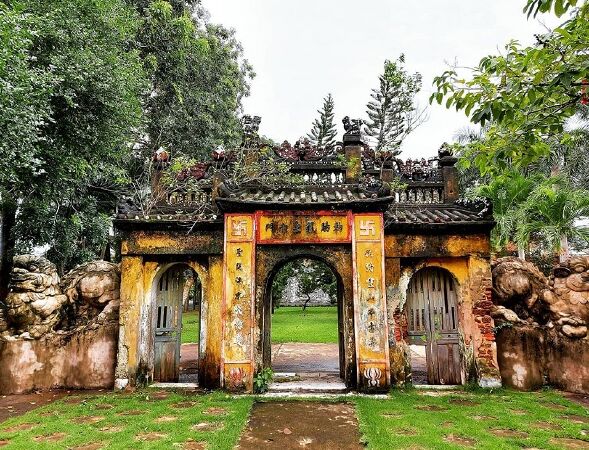
Chuc Thanh Pagoda - Photo: Pinterest
Address: Hai Ba Trung Street – Cam Pho – Hoi An
Located about 2km from the center of Hoi An ancient town, Chuc Thanh Pagoda, also known as Khoai Pagoda, is an ancient Hoi An pagoda you cannot ignore. This temple was built by the Zen master Minh Hai around the 17th century, when Hoi An was entering a flourishing period due to trade activities.
Hoi An Pagoda was built for religious purposes, imbued with Vietnamese and Chinese architectural styles, in every detail used for decoration and sharp and meticulous carvings.

